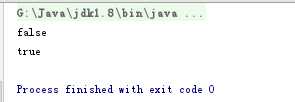标签:ecif -128 enc sys 结果 required 方法 values rally
我们首先看下面一段代码
Integer a = 1000,b=1000; System.out.println(a==b); Integer c = 100,d = 100; System.out.println(c==d);
运行结果如下

按照我们的理解,如果两个引用指向同一个对象,用==表示它们是相等的。如果两个引用指向不同的对象,==代表不相等的,即使它们的内容相同。
因此,后面一条语句应该也是false。
我们看下Integer.java类,我们会发现有一个内部私有类,IntegerCache.java,它缓存了从-128~127之间的所有的整数对象。
所以我们在声明类似——
Integer c = 100;
的时候,它实际上在内部做的是——
Integer i = Integer.valueOf(100);
我们看下valueOf()方法,可以看到
1 /** 2 * Returns an {@code Integer} instance representing the specified 3 * {@code int} value. If a new {@code Integer} instance is not 4 * required, this method should generally be used in preference to 5 * the constructor {@link #Integer(int)}, as this method is likely 6 * to yield significantly better space and time performance by 7 * caching frequently requested values. 8 * 9 * This method will always cache values in the range -128 to 127, 10 * inclusive, and may cache other values outside of this range. 11 * 12 * @param i an {@code int} value. 13 * @return an {@code Integer} instance representing {@code i}. 14 * @since 1.5 15 */ 16 public static Integer valueOf(int i) { 17 if (i >= IntegerCache.low && i <= IntegerCache.high) 18 return IntegerCache.cache[i + (-IntegerCache.low)]; 19 return new Integer(i); 20 }
如果值的范围在-128~127之间,它就从高速缓存返回实例。
所以——
Integer c = 100,d = 100;
指向同一个对象,所以输出才会是true。
为什么Java中1000==1000为false而100==100为true
标签:ecif -128 enc sys 结果 required 方法 values rally
原文地址:https://www.cnblogs.com/NullCXY/p/9746495.html